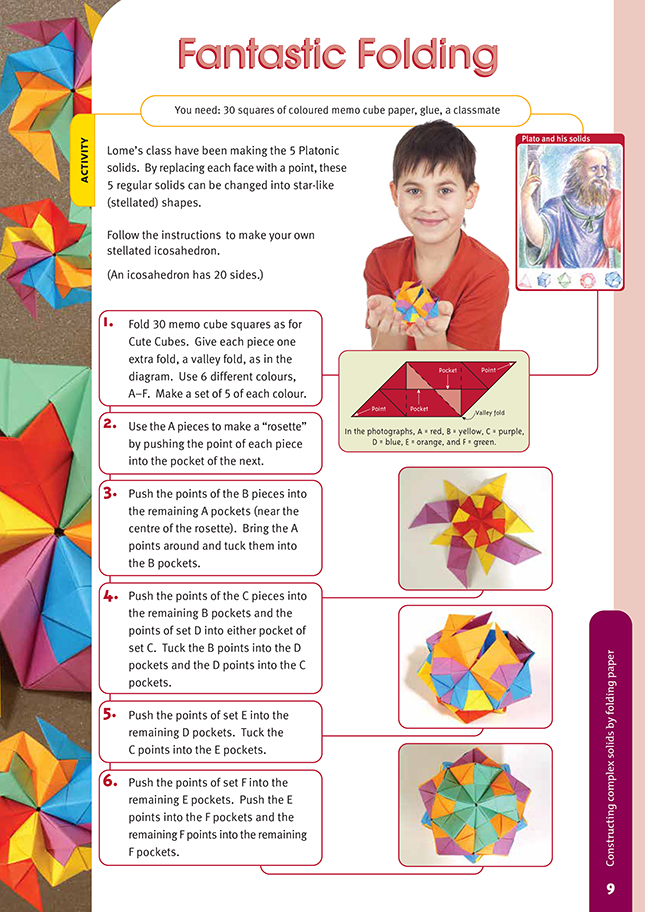This is a level 4 geometry strand activity from the Figure It Out series.
A PDF of the student activity is included.
Click on the image to enlarge it. Click again to close. Download PDF (231 KB)
follow instructions to make a three dimensional geometric shapes
FIO, Level 4, Geometry, Book One, Fantastic Folding, page 9
30 squares of coloured memo cube paper
glue
classmate
This extension to the previous activity is not easy, and you should first make the model yourself. It is, however, an excellent activity that requires students to follow instructions as well as to be precise and patient and work as a member of a team. The completed stellated icosahedron is a very attractive mathematical model.
This time, the students need 30 folded squares, so if they work in groups of 2 or 3, they can share the folding and speed up the process. Note that, this time, an extra fold is needed. The short diagonal of each parallelogram should be creased inwards on the side that has the slot down the middle. Each of these folds forms the valley between a pair of the triangular pyramids that make the icosahedron stellated.
The instructions tell the students to make 6 sets of 5 folded pieces, each set in a different colour. This makes it easy to explain the construction of the model as a series of stages, each represented by a different colour.
The key relates the colours used in the photographs to the letters AÐF used in the instructions. If these colours are available, your students could use them in the same sequence. If not, they should write down their own key, deciding which colour will be A and so on.
Once they have finished the folding, the students assemble the first set of 5 pieces in the rosette or pinwheel formation that can be seen in the top photograph in the side strip. To do this, they should push one of the points of piece 2 into one of the pockets of piece 1, one of the points of piece 3 into one of the pockets of
piece 2... and finally, one of the points of piece 1 into one of the pockets of piece 5 to complete the formation.
They will need to be systematic with their choice of pockets. They should insert each new piece from the same direction and rotate the developing structure 90 degrees after doing this.
The students may find that their assembled pieces keep falling apart. They can solve this by putting a small amount of PVA glue where the label "pocket" appears in the diagram, pushing the appropriate point into that pocket, then pressing firmly.
The rest of the instructions should be self-explanatory, but the students should keep these points in mind:
- Be systematic. What they do with 1 piece, they do with all 5 pieces of that colour. It will help if they rotate their assembled structure one-fifth of a turn after each operation before carrying out the next.
- All the pieces fit together to form 5-sided rosettes and 3-sided pyramids.
The icosahedron is one of the 5 Platonic solids. It has 20 faces, each an equilateral triangle. The stellated icosahedron has 60 triangular faces because each of the 20 faces of the icosahedron is replaced by a 3-sided pyramid. You could make one by constructing an icosahedron and then sticking a triangular pyramid to each of its faces.
The Platonic solids are explored further in Tricky Truncations, pages 8-9, Geometry: Book Two, Figure It Out, Years 7-8. A website suitable for school students is:
www.mathacademy.com/pr/prime/articles/platsol/index.asp
Answers to Activity
Practical activity
